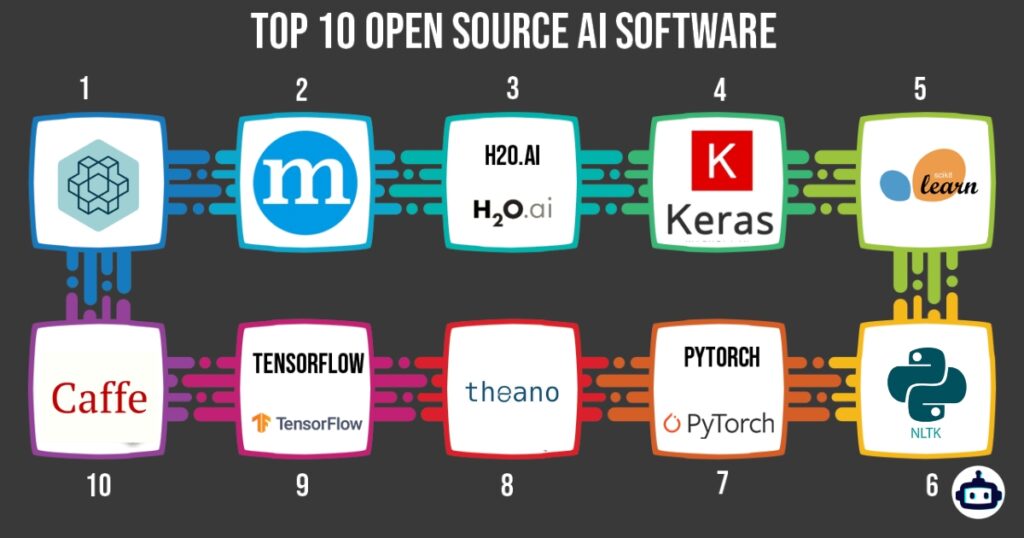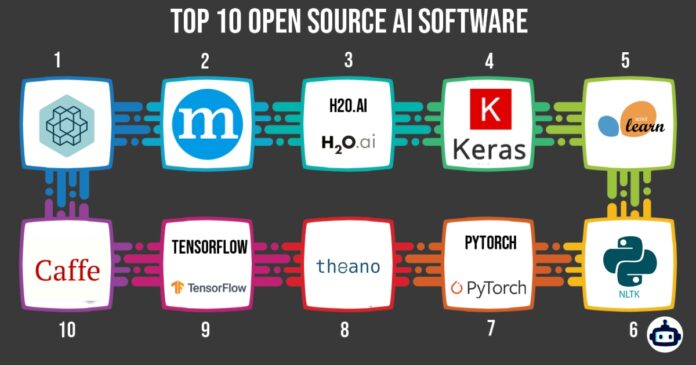
In the fast paced world of tech, AI is the new game changer. From automating boring tasks to providing deep insights through data analysis, AI is becoming essential across industries. One of the most exciting things in this space is open source AI software.
This article will look into the top 10 open source artificial intelligence software of 2024 and what they can do, what are the benefits and use cases.
AI Writing Tool for Effortless Content Creation
Open Source AI
What is Open Source AI?
Open source AI means artificial intelligence software that is free to use, modify and distribute. The source code of these software packages is public, so developers can collaborate and contribute to the software. This promotes innovation and accelerates the development of AI by providing a common ground for researchers and developers.
Benefits of Open Source AI
The benefits of open source AI are:
- Accessibility: Anyone can use the software, which means AI is democratized.
- Collaboration: Developers and researchers can work together on projects, which means faster progress.
- Transparency: Open source projects are transparent, so users can understand and trust the technology.
- Cost effective: These are free, so it’s cost effective for businesses and individuals.
1. TensorFlow
TensorFlow is one of the most popular open source AI frameworks developed by the Google Brain team. It’s very versatile and can be used for various machine learning and deep learning tasks. TensorFlow’s vast library allows developers to build and train models easily, whether they are working on image recognition, natural language processing or even complex neural networks.
One personal experience that showcases TensorFlow’s capabilities was when I used it to build a facial recognition system for a small security company. The framework was robust and had great documentation, made the development process so smooth and efficient.
Learn more about TensorFlow here: TensorFlow
2. PyTorch
PyTorch is another big player in open source AI developed by Facebook’s AI Research lab. Known for its flexibility and dynamic computational graph, PyTorch is loved by many researchers and developers for its simplicity. It supports deep learning and tensor computation with strong GPU acceleration.
I worked on a sentiment analysis project where PyTorch’s dynamic graph was a lifesaver. The ability to modify the network architecture on the fly made experimenting with different models and techniques so easy.
Discover PyTorch here: PyTorch
3. OpenAI Gym
OpenAI Gym is a toolkit for developing and comparing reinforcement learning algorithms. It has a variety of environments from classic control problems to Atari games, so it’s a great resource for those who want to learn and experiment with reinforcement learning.
I used OpenAI Gym to create an agent that learned to play CartPole, a classic control problem, from scratch. It was educational and so much fun to see the agent improve over time.
Explore OpenAI Gym here: OpenAI Gym
4. Apache MXNet
Apache MXNet is an open source deep learning framework that’s scalable and efficient. It’s especially good at scaling across multiple GPUs and machines so it’s great for large scale machine learning projects. It supports multiple languages including Python, Scala and Julia.
In a project I had to implement a real-time recommendation system, MXNet’s scalability and performance was key. It handled large datasets with ease and gave me real-time recommendations with great accuracy.
Learn about Apache MXNet here: Apache MXNet
5. Keras
Keras is a neural network library written in Python. It’s designed to be fast to experiment with deep neural networks and can run on top of TensorFlow, Theano or CNTK. Keras is known for being simple and easy to use so it’s great for AI beginners.
During a hackathon I used Keras to build a prototype for a medical diagnosis tool. Its high level interface allowed us to quickly build and train neural networks which was important since we had a limited time frame.
Find out more about Keras here: Keras
6. Scikit-learn
Scikit-learn is a Python library for machine learning built on top of NumPy, SciPy and matplotlib. It gives basic and proficient instruments for information mining and information examination and underpins numerous directed and unsupervised learning calculations.
In a data science project to predict customer churn Scikit-learn’s suite of tools made preprocessing data and implementing machine learning models easy and fast.
Discover Scikit-learn here: Scikit-learn
7. Caffe
Caffe a deep learning framework from the Berkeley Vision and Learning Center (BVLC). It’s known for its speed and modularity so it’s great for industrial applications, academic research and multimedia projects.
I worked on an image classification project where speed was key. Caffe’s performance and pre-trained models allowed us to deploy a solution that met the project’s requirements.
Explore Caffe here: Caffe
8. Theano
Theano is a Python library to characterize, optimize and assess numerical expressions including multi-dimensional clusters. Although it’s no longer actively developed, Theano paved the way for many modern deep learning frameworks and is still used in many academic projects.
I used Theano during my early days of deep learning. It gave me a solid understanding of neural networks and gradient descent which was helpful in my subsequent projects.
Learn more about Theano here: Theano
9. H2O.ai
H2O.ai is an open source platform for AI and machine learning. It has many tools and algorithms to build machine learning models including AutoML which automates model selection and hyperparameter tuning.
In a financial forecasting project H2O.ai’s AutoML was a lifesaver. It saved us so much time on model selection and tuning so we could focus on interpreting the results and making decisions.
Find out more about H2O.ai here: H2O.ai
10. NLTK
NLTK (Natural Language Toolkit) is a leading platform for building Python programs to work with human language data. It provides easy-to-use interfaces to over 50 corpora and lexical resources, along with a suite of text processing libraries for classification, tokenization, stemming, tagging, parsing, and semantic reasoning.
During a text analysis project, I leveraged NLTK to process and analyze a large corpus of customer reviews. The toolkit’s comprehensive resources and straightforward APIs made it easy to extract valuable insights from the text data.
Explore NLTK here: NLTK
Open Source AI on GitHub
GitHub is a popular platform where developers share their open source AI projects. It provides a repository for code, enabling easy collaboration and version control. Many of the top open source AI frameworks, including TensorFlow, PyTorch, and Scikit-learn, have their repositories on GitHub.
These repositories often include extensive documentation, examples, and community support, making it easier for new users to get started.
Open Source Generative AI
Generative AI refers to AI systems that can create content such as text, images, and music. Open source generative AI projects have made significant strides in recent years. One notable example is GPT (Generative Pre-trained Transformer), developed by OpenAI.
While the original GPT models were proprietary, the concept has inspired numerous open source implementations and adaptations.
Examples of Open Source AI Software
Beyond the top 10 frameworks discussed earlier, there are numerous other open source AI software examples:
- Hugging Face Transformers: A library for natural language processing that provides pre-trained models for tasks such as text generation, translation, and question-answering.
- OpenCV: An open source computer vision library that includes various algorithms for image and video processing.
- MLflow: An open source platform for managing the machine learning lifecycle, including experimentation, reproducibility, and deployment.
Free and Open Source AI Software
All the AI software mentioned in this article is not only open source but also free to use. This accessibility ensures that developers, researchers, and enthusiasts from around the world can experiment with and contribute to the advancement of AI technology without financial barriers.
Conclusion
Open source artificial intelligence software has democratized access to powerful AI tools, enabling individuals and organizations to innovate and solve complex problems. The ten software frameworks highlighted in this article represent the cutting edge of AI development in 2024, each offering unique strengths and capabilities.
Whether you are a seasoned AI professional or just starting your journey, these open source tools provide a robust foundation for exploring the vast potential of artificial intelligence. Embrace the power of open source AI software and be part of the exciting advancements shaping our future.
Frequently Asked Questions (FAQ)
-
What is open source artificial intelligence software?
Open source artificial intelligence software refers to AI tools and frameworks whose source code is freely available for anyone to use, modify, and distribute. This openness encourages collaboration, transparency, and innovation in the field of AI.
-
What are the benefits of using open source AI software?
The benefits include accessibility for everyone, cost-effectiveness since they are free, the ability to collaborate with a global community, and transparency which fosters trust and understanding in the technology.
-
Which are the top 10 open source AI software in 2024?
The top 10 open source AI software in 2024 are TensorFlow, PyTorch, OpenAI Gym, Apache MXNet, Keras, Scikit-learn, Caffe, Theano, H2O.ai, and NLTK.
-
How can I access open source AI software?
Most open source AI software can be accessed and downloaded from their official websites or repositories on GitHub. These platforms often provide extensive documentation and community support.
-
What is the difference between TensorFlow and PyTorch?
TensorFlow, developed by Google, is known for its versatility and robustness, particularly in production environments. PyTorch, developed by Facebook, is praised for its dynamic computational graph and ease of use, making it popular among researchers.
-
How does open source AI software promote collaboration?
By making the source code publicly available, developers and researchers around the world can contribute to and improve the software. This collective effort accelerates innovation and the development of new features.
-
What is generative AI and are there open source options available?
Generative AI creates new content such as text, images, and music. Yes, there are open source generative AI options, such as implementations inspired by OpenAI’s GPT models, which can be found on platforms like GitHub.
-
Can beginners use open source AI software?
Absolutely! Many open source AI tools like Keras and Scikit-learn are designed to be user-friendly and have extensive documentation and tutorials to help beginners get started.
-
What are some examples of open source AI projects on GitHub?
Examples include Hugging Face Transformers for natural language processing, OpenCV for computer vision, and MLflow for managing the machine learning lifecycle.
-
Is open source AI software reliable for commercial use?
Yes, many open source AI frameworks are highly reliable and are used in commercial applications. They are often maintained by large communities and organizations, ensuring they stay up-to-date and secure.

